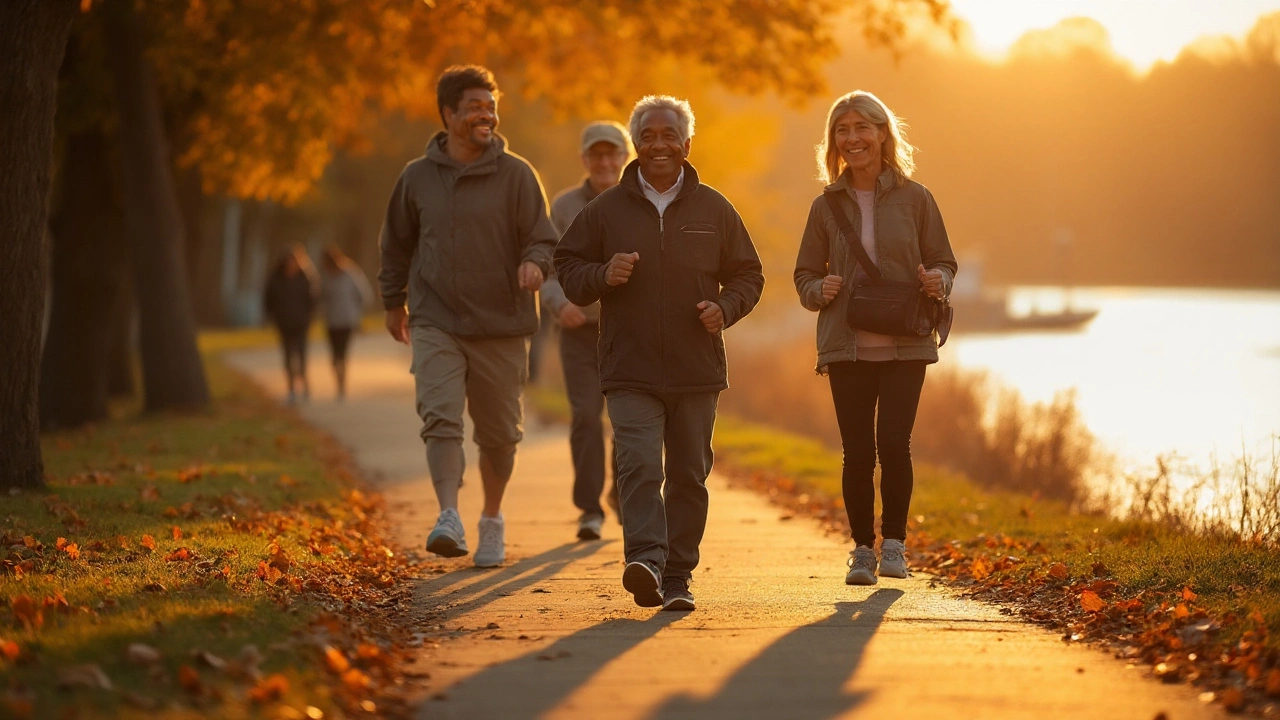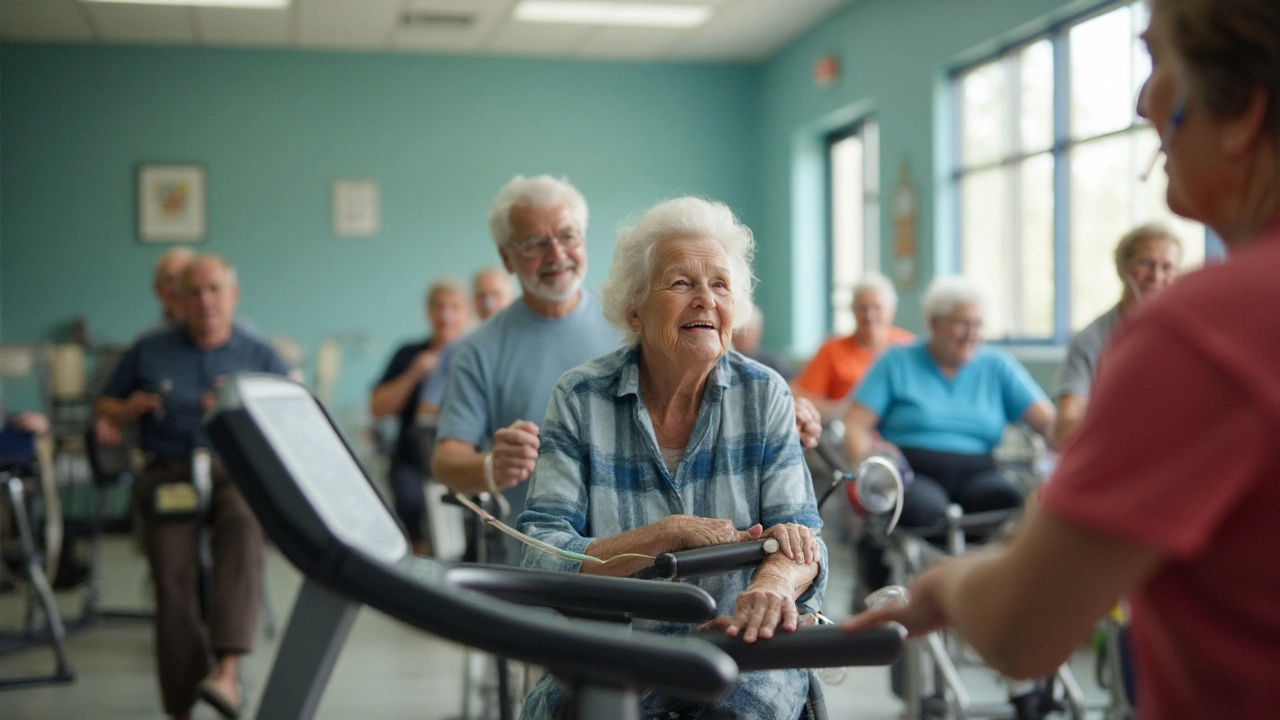Breathlessness steals everyday moments. A short walk to the shop turns into three stops on the way, and stairs feel like mountains. That’s the gap pulmonary rehabilitation closes-not by curing emphysema, but by retraining your body and mind so you can do more with the lungs you have.
TL;DR: Key takeaways
- Pulmonary rehab (PR) helps people with emphysema breathe easier, move more, and feel more in control. Benefits often appear within 4-8 weeks.
- Expect supervised exercise, breathing training, education, and a home plan. It’s tailored to your limits and medical history.
- Typical wins: longer walking distance, fewer flare-ups and hospital stays, better confidence with daily tasks.
- PR is recommended by GOLD, NICE, and ATS/ERS for COPD, including emphysema. In the UK, it’s provided by the NHS after GP/respiratory referral.
- It’s not a cure, but it’s one of the highest-value treatments you can do alongside inhalers, vaccines, and stopping smoking.
Why pulmonary rehab helps emphysema: the real benefits
Your lungs have changed, but your muscles, mindset, and habits can change too. Emphysema creates hyperinflation (air trapped in the lungs), weakens the respiratory pump, and makes you avoid activity. That inactivity leads to deconditioned leg and core muscles, which then demand more oxygen for the same effort. PR breaks that loop.
What improves and why:
- Breathlessness and stamina: Targeted leg and whole-body training makes your muscles more efficient, so they need less oxygen at a given pace. You feel less out of puff for the same task.
- Confidence and pacing: Coaching on pacing, energy conservation, and symptom spotting helps you move without panic. Anxiety drops; control grows.
- Airflow and breathing mechanics: Techniques like pursed-lip breathing reduce dynamic hyperinflation-less air-trapping means a calmer chest.
- Flare-up risk: Education on inhaler technique, trigger avoidance, early antibiotics/steroids when appropriate, and vaccines lowers the chance of exacerbations.
- Daily life: Climbing stairs, carrying shopping, showering without rest breaks-these are common wins cited by graduates.
What the evidence says:
- NICE COPD guideline NG115 (last updated 2023) recommends PR for people with COPD who are functionally limited by breathlessness, including after a hospital admission.
- The GOLD 2024 report calls PR a core, high-value treatment that improves exercise capacity and health-related quality of life.
- An ATS/ERS 2021 statement outlines PR as a comprehensive, supervised programme-exercise plus education-not just a gym session.
- Cochrane reviews (e.g., McCarthy et al., 2015 update) show meaningful gains in walking distance and quality of life, with reduced subsequent hospitalisations.
Important reality check: PR is safe for most people, highly adaptable, and designed around your other conditions (heart disease, diabetes, arthritis). It’s not about pushing through pain or gasping; it’s about training smart.

What to expect: from referral to results
Here’s the typical journey in the UK (NHS setup; formats vary a little by region):
- Referral and triage
- Your GP or respiratory team submits a referral. If you’ve been admitted with a COPD flare-up, referral should follow discharge.
- Some areas offer remote or hybrid programmes if travel is hard or waiting lists are long.
- Baseline assessment (60-90 minutes)
- History, medication check, and inhaler technique review.
- Functional test: 6-minute walk test or shuttle walk. They may check oxygen saturations and heart rate response.
- Questionnaires for breathlessness and mood. This sets a safe starting point.
- Programme structure (usually 6-8 weeks)
- Two supervised sessions per week, plus a home plan. Some programmes run 8-12 weeks if you need a slower build.
- Each session mixes aerobic training (walking, cycling, stepper), resistance work (legs, arms, core), and breathing techniques.
- Education topics: managing breathlessness, pacing, nutrition, sleep, anxiety, flare-up plans, vaccines, and quitting smoking.
- Intensity and progression
- They use simple scales like the Borg breathlessness scale (0-10). Aim for 3-4: “moderate to somewhat hard.”
- Progress comes by small nudges: 1-2 more minutes, a slightly higher seat on the bike, a tiny speed bump on the treadmill.
- Graduation and maintenance
- Re-test walking distance and update your plan for home or community classes.
- You’ll leave with a written programme and targets. Keeping the habit is where the long-term wins happen.
How fast will you notice changes? Many people feel steadier with breath control within two weeks and see walking distance rise by week four. Stairs and hills get friendlier by the end of the course. In a hilly city like Sheffield, that can mean fewer rest stops between bus stops.
Exercises, tools, and a practical checklist
Common exercises you’ll learn (and how they help):
- Walking intervals: Build stamina without spiking breathlessness. Example: 2 minutes walk, 1 minute easy roll, repeat 6-8 times.
- Stationary cycling: Lower joint load, great for leg endurance and pacing.
- Sit-to-stands: Functional power for getting out of chairs and climbing stairs.
- Step-ups: Controlled, repeatable “stair” practice to prepare for hills and real steps.
- Resistance bands: Upper-body strength for carrying shopping and using arms without breath-holding.
- Breathing drills: Pursed-lip breathing (PLB), diaphragmatic breathing, recovery positions.
Pursed-lip breathing (your pocket tool):
- Inhale through your nose for 2 counts.
- Purse your lips like you’re gently blowing out a candle.
- Exhale for 4 counts-slow, steady. Don’t force it. Repeat until your breathing eases.
Recovery positions when breathless:
- Standing: Lean forward, hands on thighs, relax your shoulders.
- Sitting: Elbows on knees, long exhale through pursed lips.
- High surface: Lean your forearms on a counter or rail during hills or stairs.
Decision cues while exercising:
- Target breathlessness: 3-4 out of 10. Too easy (1-2)? Nudge up. Too hard (5-6)? Ease back.
- Oxygen warning: If you use a pulse oximeter and see sustained sats below ~88-90% or feel dizzy/chest pain, stop and tell your team.
- Lungs not happy today? Swap to shorter intervals, lower loads, and more breathing drills. Consistency beats hero days.
Simple weekly structure you can keep after PR:
- Endurance: 3 days/week (walk or cycle 20-40 minutes with breaks).
- Strength: 2 days/week (legs, arms, core, 2-3 sets of 8-12 reps).
- Breathing and mobility: daily 5-10 minutes.
Cheat-sheet: pacing and energy conservation (think “STOPP”)
- Set the task: break big chores into chunks.
- Time your effort: plan rests every 5-10 minutes.
- Organise: keep items at waist height; avoid bending and reaching.
- Posture: slight forward lean on hills; use rails.
- Pursed lips: breathe out slow during effort (standing up, lifting).
Medication and flare-up checklist:
- Inhalers: Get your technique checked. Use a spacer if recommended.
- Vaccines: Keep flu, COVID-19, and pneumococcal jabs up to date.
- Action plan: Know your first steps for flare signs-more breathless, more cough/phlegm, colour change. Have rescue meds if prescribed.
- Air quality: On high-pollution days, do shorter indoor sessions. Consider a face covering outdoors if cold air triggers symptoms.
Nutrition and daily habits that help training stick:
- Protein at each meal supports muscle adaptation (eggs, yoghurt, beans, fish, chicken).
- Hydrate; dry airways feel tighter. Aim for regular sips through the day unless you have fluid limits.
- Sleep: A steady bedtime routine helps exercise recovery and anxiety.
- Smoking: Stopping brings real gains even after a long history. Ask for support; PR teams can link you in.
What results look like in numbers (typical ranges):
| Outcome | Typical baseline | Post-PR change | Source |
|---|---|---|---|
| 6-minute walk distance | 250-400 m | +30 to +80 m | Cochrane Review (McCarthy et al., 2015 update); GOLD 2024 |
| Breathlessness in daily tasks | MRC 3-4 | Often ↓ by ~1 point | NICE NG115 evidence summaries |
| Quality of life (SGRQ) | Impaired | ↓ 4-8 units (better) | Cochrane; ATS/ERS 2021 statement |
| Hospital admissions (12 months) | Recent exacerbation | Lower risk after PR | NICE NG115; GOLD 2024 |
| Anxiety/depression symptoms | Common | Meaningful reduction | ATS/ERS 2021; UK National COPD Audit Programme |
These are averages from large studies. Your starting point, other conditions, and attendance matter. Finishing the course-and keeping some of it going-makes the biggest difference.

FAQs and next steps
Who is PR for?
Anyone with COPD, including emphysema, who is limited by breathlessness in daily life. NICE specifically supports PR after a hospital-treated exacerbation and for people with an MRC breathlessness score of 2 or more.
Is it safe if I’m older or have heart problems?
Yes-programmes screen you, monitor vital signs, and tailor intensity. If you have unstable angina, severe heart failure, or recent clots, your team will adjust timing and plan with your cardiologist.
Do I need oxygen to join?
No. People with and without home oxygen attend. If your saturations dip during tests, the team will guide safe use of ambulatory oxygen or adjust workload.
How long do benefits last?
Gains are strongest right after the course. To hold onto them, keep moving: community classes, home plans, or walking groups. Many services offer maintenance options or re-referral after a gap.
Can I do PR at home?
Yes, many areas offer remote or hybrid programmes with video sessions and loaned equipment. Outcomes are good when you engage and track progress.
Will PR fix my lungs?
It won’t reverse emphysema, but it can reduce symptoms and boost function. Think of it like putting a stronger engine in your legs and teaching you better driving skills.
What about Sheffield specifics?
Hills, wind, and colder winters can provoke breathlessness. PR teaches strategies for gradients, layering, and using recovery positions at bus stops or on steep streets.
What if I’m still smoking?
Still come. You’ll get direct support to quit, which multiplies the benefit of rehab and your inhalers.
Next steps if you’re ready:
- Ask your GP or respiratory nurse for a PR referral (NHS). If you’ve had a recent flare-up, mention it-post-exacerbation PR is a priority.
- Gather your info: inhaler list, other meds, recent hospital letters, and any home oxygen details.
- Show up to the assessment even if you feel unfit. That’s the point.
- Block out session times in your calendar like medical appointments. Consistency wins.
- Set one personal goal that matters (e.g., “walk to the local shop without stopping”). Share it with your team.
Troubleshooting common snags:
- Transport is hard: Ask about community venues, patient transport, or remote programmes. Some centres partner with leisure facilities.
- Anxiety or panic on exertion: Tell your team. They’ll use breathing drills, slower progressions, and simple CBT-style strategies.
- Arthritis or balance issues: Cycling, seated strength work, and rails keep you safe while still building stamina.
- Recent chest infection: Finish antibiotics, clear fever, and reschedule. Restart gently with more frequent rests.
- Home is busy: Short, frequent 10-minute bursts count. Split strength work across the day.
Simple home starter (until your course begins):
- Every other day: 5 cycles of 2 minutes easy walk + 1 minute rest.
- Twice a week: 2 sets of 8 sit-to-stands, 8 step-ups each leg, 8 band rows. Rest as needed.
- Daily: 3 minutes of pursed-lip breathing and gentle stretches.
Keep your wins visible: jot down your walk time, number of rest breaks, and how your chest felt. Tiny progress is still progress. And if a Sheffield hill still bites, remember you’ve now got tools to handle it-steady pace, soft exhale, quick reset, then onward.

eko lennon
September 5, 2025 AT 17:55
The moment I first stepped into a pulmonary rehab gym, the world seemed to tilt on a new axis.
Every breath felt like a reluctant guest at a grand banquet, whispering doubts that echoed louder than the treadmill's hum.
Yet the therapists, like seasoned conductors, coaxed a symphony from my lungs, each note a promise of reclaimed freedom.
Week after week, the cycling seat became a throne of perseverance, the leg presses a rite of passage toward dignity.
I watched my six‑minute walk distance climb like a mountain goat scaling sheer cliffs, each meter a triumph over the invisible shackles of hyperinflation.
The pursed‑lip breathing drills, once alien rituals, transformed into gentle breezes that soothed the restless chest.
Education sessions, drenched in GOLD and NICE guidelines, armed me with a lexicon of self‑advocacy that felt almost revolutionary.
Even the simple act of stepping onto a bus became less of a disaster and more of a predictable choreography.
I learned to pace myself, to listen to the subtle feedback of my own body, and to celebrate every small victory without fanfare.
The community of fellow patients, each bearing their own stories of smoke and struggle, wove a tapestry of shared resilience.
In those group circles, laughter echoed louder than wheezes, and hope sprouted in the most unexpected corners.
My anxiety, once a constant companion, receded as confidence took its place, guided by mindful relaxation techniques.
The program’s adaptability meant my heart condition and arthritis never felt like barriers, only variables to be adjusted.
By the final session, the scale of improvement was measurable: a thirty‑meter boost in walking distance, a softer rating on the Borg scale, and a lighter heart when climbing the stairs of my flat.
But beyond the numbers, the true reward was the quiet assurance that I could still write my own narrative, chapter by empowered chapter.
Pulmonary rehab did not cure my lungs, but it gifted me the tools to navigate them with grace.
And that, dear readers, is the drama of triumph over breathlessness.
Sunita Basnet
September 6, 2025 AT 16:09
Pulmonary rehab offers a multidisciplinary approach leveraging exercise physiology, respiratory therapy, and health education to modulate dyspnea perception and improve functional capacity. The protocol typically incorporates interval training, resistance conditioning, and inspiratory muscle training. Evidence from NICE NG115 and GOLD 2024 underscores its impact on six‑minute walk distance and health‑related quality of life indices. Patient adherence is optimized through behavior change techniques and self‑management planning. Inhaler technique optimization and vaccination status review are integrated components for exacerbation risk reduction.
Melody Barton
September 7, 2025 AT 14:22
You can do this. Start with short walks, push a little farther each day, and use the breathing drills every time you feel tight. No need to overthink – just move, breathe, repeat. If the trainer tells you to go harder, do it, but listen to your body. You’ll build strength fast.
Justin Scherer
September 8, 2025 AT 12:35
Honestly the program is pretty chill. Two sessions a week, some walking, a bit of cycling and you’ll notice you can take the stairs without huffing. Just show up and follow the plan.
Pamela Clark
September 9, 2025 AT 10:49
Oh great, another "miracle" that promises you’ll run marathons after a few weeks of wheezing. Because we all know breathing exercises are the answer to everything, right?
Diane Holding
September 10, 2025 AT 09:02
Sounds good.
Cheyanne Moxley
September 11, 2025 AT 07:15
Listen, if you’re still smoking while pretending to be “motivated,” you’re just kidding yourself. Real change means quitting the habit, not just signing up for a class and hoping for a miracle.
Kevin Stratton
September 12, 2025 AT 05:29
In the grand tapestry of existence, each breath is a thread-woven, frayed, yet eternally resilient. Embrace the rhythm of inhalation and exhalation, for they are the pulse of consciousness. :)
Manish Verma
September 13, 2025 AT 03:42
Honestly, it's about time we recognize that our own health programs are top‑notch compared to any other system. If you’re not using them, you’re missing out on a uniquely Aussie‑crafted path to recovery.
Lionel du Plessis
September 14, 2025 AT 01:55
Yo the rehab vibe is lowkey solid; you get the cardio load, the muscle work, and the breath hacks all in one flow. No drama just data and progress.
Andrae Powel
September 15, 2025 AT 00:09
Absolutely, the multidisciplinary team can really tailor the intensity based on comorbidities. It’s key to monitor vitals and adjust the program to keep it safe and effective.
Leanne Henderson
September 15, 2025 AT 22:22
Wow, what a wonderful summary! Your positivity really shines through, and it’s inspiring to see how each small step builds confidence, strength, and resilience! Keep it up, you’re on the right track! :)
Megan Dicochea
September 16, 2025 AT 20:35
The recommendations are solid, especially the emphasis on consistency. Even a brief daily routine can add up over weeks. Pair it with proper nutrition for best results.
Jennie Smith
September 17, 2025 AT 18:49
Imagine your lungs as a garden-each breath a seed. With rehab, you water the roots, prune the overgrown vines of breathlessness, and watch a vibrant canopy of ease bloom. 🌿
Greg Galivan
September 18, 2025 AT 17:02
Ths program is reallly no brainer. If u cant stick to it wre a tme waasting. Gt it done or gt out.
Anurag Ranjan
September 19, 2025 AT 15:15
Key point: stay consistent and track progress; small gains add up over time.